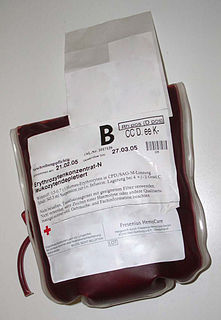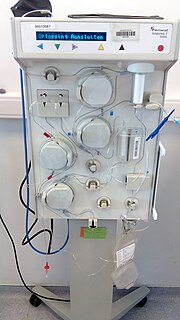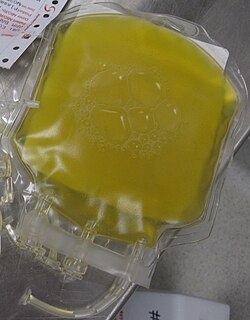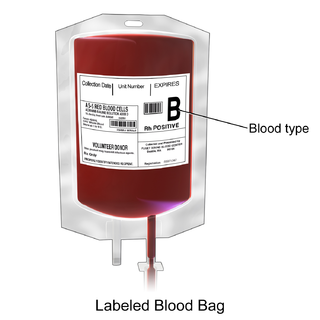Related Research Articles

A blood type is a classification of blood, based on the presence and absence of antibodies and inherited antigenic substances on the surface of red blood cells (RBCs). These antigens may be proteins, carbohydrates, glycoproteins, or glycolipids, depending on the blood group system. Some of these antigens are also present on the surface of other types of cells of various tissues. Several of these red blood cell surface antigens can stem from one allele and collectively form a blood group system.

Blood transfusion is the process of transferring blood products into a person's circulation intravenously. Transfusions are used for various medical conditions to replace lost components of the blood. Early transfusions used whole blood, but modern medical practice commonly uses only components of the blood, such as red blood cells, white blood cells, plasma, clotting factors and platelets.

Plasmapheresis is the removal, treatment, and return or exchange of blood plasma or components thereof from and to the blood circulation. It is thus an extracorporeal therapy, a medical procedure performed outside the body.

Fresh frozen plasma (FFP) is a blood product made from the liquid portion of whole blood. It is used to treat conditions in which there are low blood clotting factors or low levels of other blood proteins. It may also be used as the replacement fluid in plasma exchange. Using ABO compatible plasma, while not required, may be recommended. Use as a volume expander is not recommended. It is given by slow injection into a vein.
Intraoperative blood salvage (IOS), also known as cell salvage, is a specific type of autologous blood transfusion. Specifically IOS is a medical procedure involving recovering blood lost during surgery and re-infusing it into the patient. It is a major form of autotransfusion.

Transfusion-related acute lung injury (TRALI) is the serious complication of transfusion of blood products that is characterized by the rapid onset of excess fluid in the lungs. It can cause dangerous drops in the supply of oxygen to body tissues. Although changes in transfusion practices have reduced the incidence of TRALI, it was the leading cause of transfusion-related deaths in the United States from fiscal year 2008 through fiscal year 2012.

Selective immunoglobulin A (IgA) deficiency (SIgAD) is a genetic immunodeficiency, a type of hypogammaglobulinemia. People with this deficiency lack immunoglobulin A (IgA), a type of antibody that protects against infections of the mucous membranes lining the mouth, airways, and digestive tract. It is defined as an undetectable serum IgA level in the presence of normal serum levels of IgG and IgM, in persons older than 4 years. It is the most common of the primary antibody deficiencies. Most such persons remain healthy throughout their lives and are never diagnosed.
An exchange transfusion is a blood transfusion in which the patient's blood or components of it are exchanged with other blood or blood products. The patient's blood is removed and replaced by donated blood or blood components. This exchange transfusion can be performed manually or using a machine (apheresis).

Packed red blood cells, also known as packed cells, are red blood cells that have been separated for blood transfusion. The packed cells are typically used in anemia that is either causing symptoms or when the hemoglobin is less than usually 70–80 g/L. In adults, one unit brings up hemoglobin levels by about 10 g/L. Repeated transfusions may be required in people receiving cancer chemotherapy or who have hemoglobin disorders. Cross-matching is typically required before the blood is given. It is given by injection into a vein.
Type II hypersensitivity, in the Gell and Coombs classification of allergic reactions, is an antibody mediated process in which IgG and IgM antibodies are directed against antigens on cells or extracellular material. This subsequently leads to cell lysis, tissue damage or loss of function through mechanisms such as
- complement activation via the classical complement pathway
- Antibody-dependent cellular cytotoxicity or
- anti-receptor activity.

In transfusion medicine, transfusion-associated circulatory overload is a transfusion reaction resulting in signs or symptoms of excess fluid in the circulatory system (hypervolemia) within 12 hours after transfusion. The symptoms of TACO can include shortness of breath (dyspnea), low blood oxygen levels (hypoxemia), leg swelling, high blood pressure (hypertension), and a high heart rate (tachycardia).
Febrile non-hemolytic transfusion reaction (FNHTR) is the most common type of transfusion reaction. It is a benign occurrence with symptoms that include fever but not directly related with hemolysis. It is caused by cytokine release from leukocytes within the donor product as a consequence of white blood cell breakdown .These inflammatory mediators accumulate during the storage of the donated blood, and so the frequency of this reaction increases with the storage length of donated blood. This is in contrast to transfusion-associated acute lung injury, in which the donor plasma has antibodies directed against the recipient HLA antigens, mediating the characteristic lung damage.
An acute hemolytic transfusion reaction (AHTR), also called immediate hemolytic transfusion reaction, is a life-threatening reaction to receiving a blood transfusion. AHTRs occur within 24 hours of the transfusion and can be triggered by a few milliliters of blood. The reaction is triggered by host antibodies destroying donor red blood cells. AHTR typically occurs when there is an ABO blood group incompatibility, and is most severe when type A donor blood is given to a type O recipient.
Plasma frozen within 24 hours after phlebotomy, commonly called FP24, PF‑24, or similar names, is a frozen human blood plasma product used in transfusion medicine. It differs from fresh-frozen plasma (FFP) in that it is frozen within 24 hours of blood collection, whereas FFP is frozen within 8 hours. The phrase "FFP" is sometimes used to refer to any frozen blood plasma product intended for transfusion.
Red blood cells (erythrocytes) from donors contain normal hemoglobin (HbA), and transfusion of normal red blood cells into people with sickle cell disease reduces the percentage of red cells in the circulation containing the abnormal hemoglobin (HbS). Although transfusion of donor red blood cells can ameliorate and even prevent complications of sickle cell disease in certain circumstances, transfusion therapy is not universally beneficial in sickle cell disease.
Washed red blood cells are red blood cells which have had most of the plasma, platelets and white blood cells removed and replaced with saline or another type of preservation solution. The most common reason for using washed red blood cells in transfusion medicine is to prevent the recurrence of severe allergic transfusion reactions that do not respond to medical treatment. The usual cause of these allergic reactions is proteins in the donor plasma. These proteins are removed by the process of washing the red blood cells.
Neonates are defined as babies up to 28 days after birth. Most extremely preterm babies require at least one red cell transfusion; this is partly due to the amount of blood removed with blood samples compared to the baby's total blood volume and partly due to anemia of prematurity. Most transfusions are given as small volume top-up transfusions to increase the baby's hemoglobin above a certain pre-defined level, or because the baby is unwell due to the anemia. Possible side-effects of anemia in babies can be poor growth, lethargy and episodes of apnea. Exchange blood transfusion is used to treat a rapidly rising bilirubin that does not respond to treatment with phototherapy or intravenous immunoglobulin. This is usually due to hemolytic disease of the newborn, but may also be due to other causes, e.g., G6PD deficiency.
An allergic transfusion reaction is when a blood transfusion results in allergic reaction. It is among the most common transfusion reactions to occur. Reported rates depend on the degree of active surveillance versus passing reporting to the blood bank. Overall, they are estimated to complicate up to 3% of all transfusions. The incidence of allergic transfusion reactions is associated with the amount of plasma in the product. More than 90% of these reactions occur during transfusion.

Blood compatibility testing is conducted in a medical laboratory to identify potential incompatibilities between blood types in blood transfusion. It is also used to diagnose and prevent some complications of pregnancy that can occur when the baby has a different blood group from the mother. Blood compatibility testing includes blood typing, which detects the antigens on red blood cells that determine a person's blood type; testing for unexpected antibodies against blood group antigens ; and, in the case of blood transfusions, mixing the recipient's plasma with the donor's red blood cells to detect incompatibilities (crossmatching). Routine blood typing involves determining the ABO and RhD type, and involves both identification of ABO antigens on red blood cells and identification of ABO antibodies in the plasma. Other blood group antigens may be tested for in specific clinical situations.
A granulocyte transfusion is a medical procedure in which granulocytes are infused into a person's blood. Granulocyte transfusions were historically used to prevent and treat infections in people with neutropenia, but the practice declined in popularity in the 1980s. Interest in the procedure increased in the 1990s due to the development of more effective methods for harvesting granulocytes and a growing population of people with severe neutropenia from chemotherapy. However, the treatment's efficacy remains poorly understood and its use is controversial.
References
- 1 2 3 4 5 Bolton-Maggs, Paula H. B.; Cohen, Hannah (1 November 2013). "Serious Hazards of Transfusion (SHOT) haemovigilance and progress is improving transfusion safety". British Journal of Haematology. 163 (3): 303–314. doi:10.1111/bjh.12547. ISSN 1365-2141. PMC 3935404 . PMID 24032719.
- ↑ Peters, Anna L.; van Hezel, Maike E.; Juffermans, Nicole P.; Vlaar, Alexander P. J. (January 2015). "Pathogenesis of non-antibody mediated transfusion-related acute lung injury from bench to bedside". Blood Reviews. 29 (1): 51–61. doi:10.1016/j.blre.2014.09.007. ISSN 1532-1681. PMID 25277811.
- ↑ Müller, Marcella C. A.; van Stein, Danielle; Binnekade, Jan M.; van Rhenen, Dick J.; Vlaar, Alexander P. J. (January 2015). "Low-risk transfusion-related acute lung injury donor strategies and the impact on the onset of transfusion-related acute lung injury: a meta-analysis". Transfusion. 55 (1): 164–175. doi:10.1111/trf.12816. ISSN 1537-2995. PMID 25135630.
- 1 2 Peters, Anna L.; Van Stein, Danielle; Vlaar, Alexander P. J. (September 2015). "Antibody-mediated transfusion-related acute lung injury; from discovery to prevention". British Journal of Haematology. 170 (5): 597–614. doi: 10.1111/bjh.13459 . ISSN 1365-2141. PMID 25921271.
- 1 2 3 Stainsby, Dorothy; Jones, Hilary; Asher, Deborah; Atterbury, Claire; Boncinelli, Aysha; Brant, Lisa; Chapman, Catherine E.; Davison, Katy; Gerrard, Rebecca (1 October 2006). "Serious Hazards of Transfusion: A Decade of Hemovigilance in the UK". Transfusion Medicine Reviews. 20 (4): 273–282. doi:10.1016/j.tmrv.2006.05.002. PMID 17008165.
- 1 2 3 Williamson, L M; Lowe, S; Love, E M; Cohen, H; Soldan, K; McClelland, D B L; Skacel, P; Barbara, J A J (3 July 1999). "Serious hazards of transfusion (SHOT) initiative: analysis of the first two annual reports". BMJ: British Medical Journal. 319 (7201): 16–19. doi:10.1136/bmj.319.7201.16. ISSN 0959-8138. PMC 28147 . PMID 10390452.